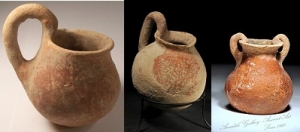9. Ceramic Development in the Middle East
| 889 Page: 141 of 418 Go To Page: | ◁◁ First | ◁ Previous | Next ▷ | Last ▷▷ |
9.2 Jericho
Of the larger settlements, Jericho or Tell Sultan, in present Israel, is one of the oldest in the world. The lowest levels of its excavation correspond to the Natufian period, so it was settled before 10,000 BC. Around 9,000 BC the inhabitants constructed a 4.5m high, 3m thick stone wall and ditch that surrounded the settlement, with at least one stone tower, 9m in diameter and over 8m high, having an internal spiral staircase. Overall some 10,000 tons of rock were used, and this is apparently the oldest stone wall ever discovered. One function of the wall could have been flood prevention. The settlement covered 10 acres, supporting probably between a few hundred and 3,000 people in circular mud brick houses. This is also possibly the earliest example we have of sun-dried brick architecture. The people obtained meat by hunting mainly gazelle but also wild cattle, boar and goats. They also ate wild Emmer wheat, barley and pulses. Stone sickles with bone handles and implements that were possibly hoes have been found.
There was a break in occupation and people of a different culture started to inhabit Jericho after about 8,500 BC. Their range of plant-food increased as they practiced simple agriculture as well as probably herding goats and sheep. By 8,000 BC they were eating fully domesticated wheat, barley and pulses. Around 7,000 BC they introduced small-scale irrigation, increasing the areas capable of growing cereals. Notably the teeth of the inhabitants were worn down by the action of the small stone chips that came from the grinding stones. Houses became rectangular, with better-shaped mud bricks on stone foundations and lime plastered floors. They fired limestone to produce the lime and it is possible that white lime/ash clay was used to make their first “pottery”. A larger building with stone walls on a rectangular platform, also from this period, may have been a shrine. The inhabitants seemed to practice an ancestor cult as they buried their dead under the floors of their homes. This is not as bad as it sounds, as they appeared to leave the bodies outside until their bones were bleached, possibly after the flesh was removed by vultures, as is depicted in pictures on their walls. Subsequently they buried them; however, sometimes they did remove the skulls and shaped them with plaster to make them look more natural, probably to use in a ritual practice. These practices illustrate the growing importance of ritual, which had a major impact on social cohesion.
Not long after 7,000 BC earthenware pottery produced in Jericho was rather crude, straw-tempered, with red painted geometric patterns, generally used for the long-term storage of food. Shortly thereafter pottery divided into rather less crude normal ware and some much-improved fine ware. The body shapes remained similar to the earlier vessels, the clay was mixed with sand or grit as temper with less straw, and the vessel walls became thinner. About the same time that Halaf pottery was popular, around 5,500 BC, pots in Jericho were hand made but turned on a mat for finishing. There were wide-rimmed jars – some with knob or ledge shaped handles, others with strap handles. There were also small cups, and simple globular bowls, some with a circumferential ridge (carinated). The wares were sometimes decorated with red wash or slip or just painted at the rim, while some wares were burnished either all over or as a pattern. Others were incised, often in a herringbone pattern, just below the rim.

High handled vessels, jar 4th Millennium BC,
cup Jericho 3,000 BC, and wine jar 3,500-2,300 BC.
a) and c) - courtesy Aweidah Galleries - Jerusalem,
b) - source Forum of Ancient Coins
Over time their method of burials changed and they started to use shaft tombs. These were made with a vertical shaft typically 6 ft deep, often cut into soft limestone that preserved the contents well. They widened out at the low end sometimes into several chambers. Around 2,500 BC, examples at a central burial site, Bab edh-Dhia in Palestine had up to 5 chambers each containing 4 to 6 individuals. This site is estimated to have contained 20,000 tombs representing half a million people and 3 million pottery vessels!
Jericho was very influential throughout the Middle East, as it was a trade centre having many visitors. It traded widely and notably, around 2,500 BC, the inhabitants were producing textiles, wine and olive oil for export to Egypt. Although it was occupied for such a long time, there were several lengthy breaks. It finally came to an end about 1,550 BC, when its walls were demolished by an earthquake or siege, possibly by the Egyptians.


